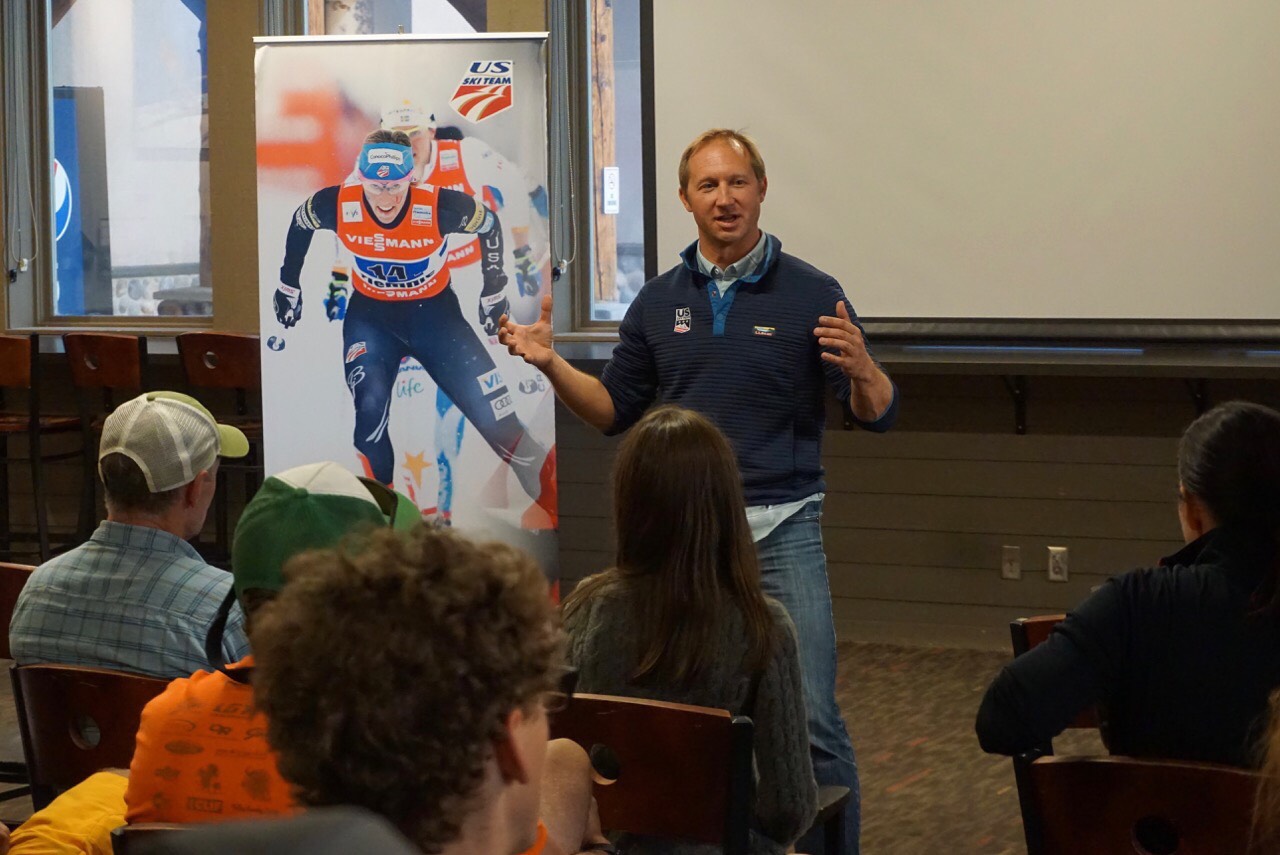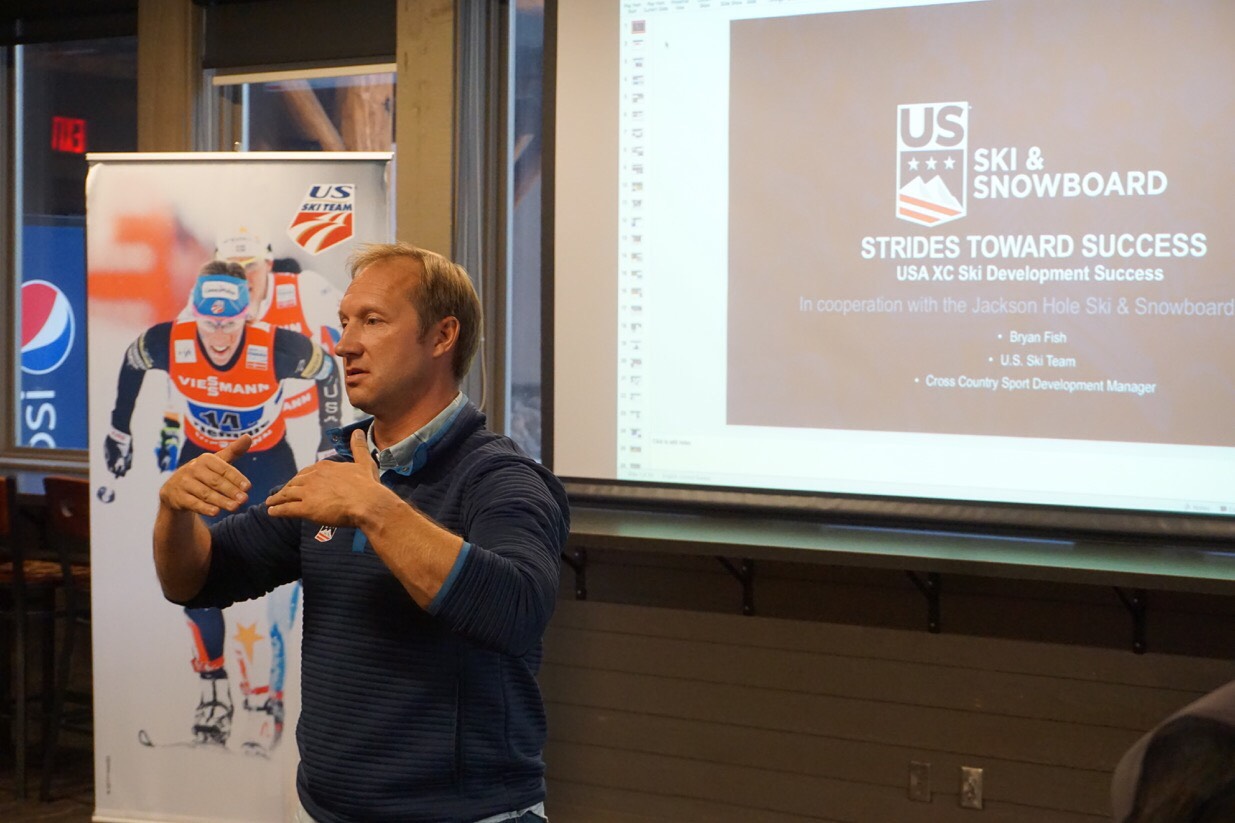
JACKSON, Wyoming — Last last month, U.S. Ski & Snowboard announced that Bryan Fish had been promoted to cross country sport development manager. FasterSkier sat down with Fish on Sept. 14 at Jackson Hole’s Center for the Arts, where he was leading a Level 200 coaching clinic, to learn more about this transition and how his new position will support the national development program. He also provided insight into the development program’s philosophy and goals for the coming years.
Fish originally joined U.S. Ski & Snowboard as the cross-country development head coach in 2010, after starting the Central Cross Country (CXC) Elite Team in Wisconsin and coaching there for four years. Before that, he was head nordic coach at his alma mater, the University of Wisconsin-Green Bay, from 1998 to 2006. During his last eight years with the national team, he has been the primary development coach and spearheaded sport education to create resources for club coaches and athletes nationwide. As U.S. nordic skiing at the elite level has steadily improved, the development program for juniors has grown and evolved in response.
“I think people look at it and they see this monumental upward trend, but it’s been kind of a slow steady progression,” Fish, 43, said. “It’s been really fun to be a part of. … You just see the whole community collectively raising the bar, and it’s been really exciting to be a part of that.”

His new sport-development manager position was created to reflect the challenges and demands of a growing development program and recognize that the current group of junior athletes has seen a unprecedented level of success in international competitions. At last season’s Junior World Championships in Switzerland, the U.S. claimed three cross-country medals; Hailey Swirbul with silver and bronze in two individual races and the U.S. junior men’s team (Luke Jager, Hunter Wonders, Gus Schumacher, and Ben Ogden) with silver in the 4 x 5-kilometer relay.
Fish’s new role will include many of his previous responsibilities while reducing certain aspects of his former position, which made it more difficult for him to focus on the development program itself.
“What we really did is took a look and evaluated ‘what are our strengths as a staff?’ How do we need to structure our sport in a way that optimizes our staff and optimizes our resources?’ ” he reflected. “So a lot of things that I was doing previously are very similar to what I am doing now.”
Additionally, a sport consultant who will be based year-round in Park City will be hired to take over office-based work such as uniforming, helping with the competition guide, and data analysis through points at the SuperTour and Junior Nationals. This person, who Fish said will be hired in the coming weeks, will devote about 80 to 85 percent of their time to cross country and the remainder to the all-sport needs of U.S. Ski & Snowboard.

“One of my strengths is working with the athletes in the field, and we want to maintain some consistency with the international competitions like Junior World Ski Championships, World U23’s, OPA Cup as well as some of the national-level junior camps that we do in the summer,” Fish said. “I will still continue to do that.
“I will no longer support World Cup,” he continued. “I’ll be a little more domestic, so I’ll be at West Yellowstone, I’ll be at Silver Star, and that actually was a plan regardless of whether I took this new position or not because the dynamic of our World Cup team and our whole national team is a lot more on the development side.”
Fish’s approach to leading the development program is focused on process goals, creating opportunities for athletes in all regions and at all levels, and providing club coaches with tools to create successful programs. He hopes to develop a systematic process for juniors to excel in skiing that’s both clear and transparent.
“One of the things I’ve been trying to focus on … is taking a deeper look at those steps from what I’ll say, cradle to grave, or from youth all the way to elite, and we’re continuing to recognize and understand that there are gaps in areas, but most importantly, it’s really important that we divide and conquer,” he said. “What I mean by that is that we’re working with our divisions, we’re working with our regions, because they do a lot of the junior racing and youth development, and we do a lot of the national and above. It’s really making sure that we have affiliation agreements with each division and I’ve been looking through those as well and making sure that there’s a clear path and opportunities for junior athletes.”
In order to gauge the success of this approach and the development of junior athletes, Fish offers an approach that is not solely based on results; in fact, success in competition is only one of the three aspects involved.
“Number one: are we growing?” he asked rhetorically. “Growth does not mean membership growth; it just means, do we have more skiers? The second thing is retention. Are we retaining the skiers? And number three is performance. Are we getting better?”
In order for these three components of growth to be possible, opportunities for athletes of all ages and abilities must be available. He described another three-step model for developing programming at any level.
“One is developing a passion for outdoor endurance athletics, number two is developing a culture of training, and then we can develop a culture of performance,” he said. “And even at that high point, a culture of performance, they need to still have that passion for outdoor endurance. So if we’re doing our job, we’re providing opportunities. So we’re making sure that there are appropriate venues, there are events — it doesn’t necessarily mean competition, but there are different events, and that there are programming, and we need to have all three of those pieces.”

Fish refers to these opportunities as part of a “pathway” for athletes, versus using the phrase “pipeline”, which is used by the U.S. Olympic Committee. He adds, “I’m not a big fan of the term ‘pipeline’. … When you think pipeline, it has one path, it goes in this pipe and this little trickle comes out the other end.”
To him, the word “pathway” implies that there are many entry points that can lead to success in skiing, especially when one’s individual goals are taken into consideration.
Fish emphasized that access to quality programming from a young age is essential to the success of U.S. skiing as a whole. He said coach education is crucial to this aspect of creating valuable opportunities for youth, as are the clubs that plant the seeds for success and are most responsible for cultivating a love of the sport.
“I wish U.S. Ski & Snowboard had the capacity to do more at a younger age, but we have to focus our efforts and really be strategic with the resources that we have,” he said. “What we are trying to do is be very transparent about that and say, ‘OK, these things we can do, these things we need you guys to do, clubs and coaches, how can we help you?’ One of the resources we are trying to provide is this coaching education, which we take real seriously, to have some common ground.”
Programming should also be similar across the country.
“We want to make sure that a skier in California is somewhat similar in level to the athlete in Maine and getting the same opportunities,” he said.
In his time with U.S. Ski & Snowboard, Fish has assisted in the development of resources for coaches, such as the Level 100 and 200 certification programs. However, in recent years, his focus has shifted away from some of the minutiae of technique and physiology toward a more pedagogical approach, which he hopes to continue to spread in his new role.
“What we wanted to do is go, ‘OK, here is our scaffolding, here are some best practices in the community for all these different things,’ ” he explained. “We’ve tried to be less detailed as it relates to nuances of technique, but instead ‘here is how you teach technique’… We all might teach it slightly different, but I hope that we can come back to our educational platform and say, ‘OK, we can all agree on that,’ and then from that we can be creative as coaches with our different age groups and resources that we have within a community.”
Fish also stated that partnership with coaches and technicians from around the country fills essential gaps in support at international junior competitions, in turn providing valuable professional development opportunities for the club staff.
“The coaching staff on the national team has been more open to having open training and have more club coaches come on trips, and for me, that collaboration is really important,” he said. “When I go to Junior Worlds, I am the only national team person, all other staff is club coaches. As time has gone by, with that collaboration and bringing more coaches and technicians over internationally and working together with them, we’ve created that trust. And we’ve also seen coaches and techs like Andrew Morehouse and Tim Baucom are now full-time wax techs [for the national team].”
Training camps are another powerful tool, Fish said.
“There’s no more powerful coach than other strong teammates and an environment of training,” he said. “A perfect example of that is our last camp that we just came from in Norway, the International Junior Camp.
“When you’re around other athletes of a similar level, the bar just raises,” he continued. “What I noticed was that it was hard on everybody, but when its hard on everybody and everybody’s doing it, it becomes normal. They’re not all stressed out and they’re not all questioning themselves. They’re just like, well, everybody else is doing it were all in the same boat here; we’re all pretty tired.”
He added that Molly Gellert said it best when she posted a photo of herself on Facebook with Sofia Shomento, an Austrian coach, and athletes from Norway and Finland smiling with their arms around each other after the last training session of the camp. The photo caption reads “Don’t let the smiles deceive you, camp was so freaking hard.”
Asked about the dilemma some athletes face when choosing whether to ski in college or take a post-graduate year, Fish said that decision should not be viewed as black and white, and it should reflect the athlete’s individual strengths and goals. Though he is often in support of a post-grad year, he understands that not all athletes at that age are mature enough to handle the transition being a full-time athlete and still need an additional outlet, such as taking classes or a part-time job.
“I look at it from a perspective of ‘what are the opportunities?’ ” he said. “When I was a college coach, I always said, ‘You need three things if this college to be right for you: the school needs to be right for you, the coach needs to be right for you, and the team needs to be right for you.’ I think you could build upon that to say, ‘Is part-time school the right approach for you?’ I really encourage athletes and their families to really identify and think deeply about what might be the right path for them. There’s no one right pathway.”
Rachel Perkins
Rachel is an endurance sport enthusiast based in the Roaring Fork Valley of Colorado. You can find her cruising around on skinny skis, running in the mountains with her pup, or chasing her toddler (born Oct. 2018). Instagram: @bachrunner4646



